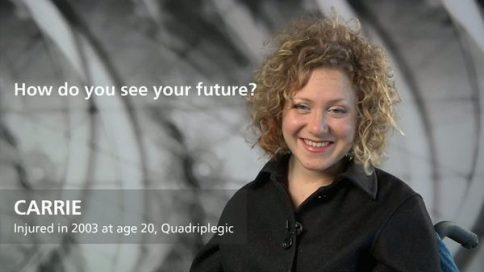What is “Braingate” research? - David Chen, MD
|
|
What is “Braingate” research? |
|
David Chen, MDMedical Director, Spinal Cord Injury Rehabilitation Program, Rehabilitation Institute of Chicago |
||
| Read Bio | More Videos by David Chen | |
|
Share |
||
Transcript
BrainGate is an idea that came up from a group out on the east coast that is looking at what we call a brain-nerve interface. The idea behind the BrainGate is to implant a small chip in the motor cortex of the brain that generates the signals for movement. Remember, a person who has a spinal cord injury, their brain, and the function of the brain, and the signals the brain creates should be intact, nothing has happened to that. But the signals that are created to send signals to different muscles, to move or to contract, are blocked by the spinal cord injury. So, the idea behind the BrainGate interface is to implant a chip that picks up the signals that are created to, let’s say, move your hand, or control a mouse, and through complex powerful computers, interpret those signals. And to be able to put those signals, let’s say, to a device that a person may not physically be able to control, but perhaps a cursor on a computer screen, a controller device on a power wheelchair, be able to control that device. This type of work is very early on right now, although the results that groups have shown with this type of device have been extremely promising. An individual, who has spinal cord injury, is looking at a screen in front of them, and they can see the cursor, and their imagining, thinking in their minds to move that cursor. When the BrainGate chip picks up that signals that are generating in the motor cortex, and these signals are routed through a connection that’s picked up by a device that goes to a computer that connects to the computer, and moves the mouse. It’s quite fascinating.
Show Less|
|
||
add
What is “Braingate” research? |
||
David Chen, MDMedical Director, Spinal Cord Injury Rehabilitation Program, Rehabilitation Institute of Chicago |
More Videos by David Chen | |
| Transcriptadd | share | |
BrainGate is an idea that came up from a group out on the east coast that is looking at what we call a brain-nerve interface. The idea behind the BrainGate is to implant a small chip in the motor cortex of the brain that generates the signals for movement. Remember, a person who has a spinal cord injury, their brain, and the function of the brain, and the signals the brain creates should be intact, nothing has happened to that. But the signals that are created to send signals to different muscles, to move or to contract, are blocked by the spinal cord injury. So, the idea behind the BrainGate interface is to implant a chip that picks up the signals that are created to, let’s say, move your hand, or control a mouse, and through complex powerful computers, interpret those signals. And to be able to put those signals, let’s say, to a device that a person may not physically be able to control, but perhaps a cursor on a computer screen, a controller device on a power wheelchair, be able to control that device. This type of work is very early on right now, although the results that groups have shown with this type of device have been extremely promising. An individual, who has spinal cord injury, is looking at a screen in front of them, and they can see the cursor, and their imagining, thinking in their minds to move that cursor. When the BrainGate chip picks up that signals that are generating in the motor cortex, and these signals are routed through a connection that’s picked up by a device that goes to a computer that connects to the computer, and moves the mouse. It’s quite fascinating.































